
US trade threats ‘raise risks for China’s industrial tech ambitions’
Washington’s proposed duties on hi-tech Chinese imports could dent Beijing’s plans to move up the industrial chain, analysts say
One of China’s major industrial ambitions could suffer setbacks if the United States makes good on its threats to slap tariffs on Chinese hi-tech products, analysts say.
With trade tensions soaring, Washington is now targeting Beijing’s “Made in China 2025” initiative, an innovation-driven strategy to turn the country into a modern industrial powerhouse.
On Thursday, US President Donald Trump brandished tariffs on an extra US$100 billion worth of Chinese imports, on top of previously announced duties, to punish China for its intellectual property “theft”, including forced technology transfers.
Washington’s punitive measures are centred on China’s hi-tech sectors, including 25 per cent tariffs on Chinese industrial, medical, aerospace, communications, and transport products.
Analysts said the spectre of these measures, along with the potential for further action such as limits on Chinese investment in the United States or US investment in China, could drag on the “Made in China 2025” initiative.

Julian Evans-Pritchard, senior China economist with British market research firm Capital Economics, said China was already facing challenges in its goal to be a global technology leader, but this would be more difficult “without access to foreign investment and foreign technology”.
While China had strived to move up in the value chain, it was still largely “a country that assembles products rather than innovates and develops the IP behind them”, Evans-Pritchard said.
“Even in the areas where it’s put a lot of resources into developing its own ability to innovate and be a market leader, for example high-speed rail … it has still struggled to turn that domestic dominance into an ability to export that technology overseas,” he said.
Vincent Chan, head of China equity research at Credit Suisse, said tariffs – and other restrictions – would dampen the Chinese tech sector’s investment in industry and technology, holding back innovation.
Chan said that both overseas and domestic manufacturers would be less likely to open new factories in China, and would veer away from new technology in the longer-term.
“Electronics have always relied on the global market, so if the global market becomes a problem, it could affect China’s 2025 initiative,” he said. “Continuous interaction between the domestic and overseas markets has always been a very important precondition for the success of Chinese technology companies.”

Jon Cowley, partner for trade at law firm Baker McKenzie, said that if the tariffs took effect, it would raise costs for affected US importers and make Chinese exporters less competitive.
“The trade tensions have prompted many companies to closely examine their supply chains and explore the feasibility of alternative sourcing locations and distribution channels,” Cowley said.
Moody’s Investors Service said China’s economic growth could take a hit if tighter foreign investment controls blocked companies using technology transfers to advance their products and services.
But China could benefit in the longer term if it moved in the direction the US had been pushing by relaxing the ruling Communist Party’s control over markets and allowing for greater productivity growth.
“We are increasingly seeing this shift towards the party wanting to maintain strong control over economic outcomes, and shore up the state sector, which is a negative trend in the long-run,” Evans-Pritchard said. “If US tariffs were used as a tool to reverse some of that, and shift the trend in a better direction, maybe it’s actually a good thing.”

